Karuta
Karuta (かるた, from Portuguese carta ["card"])[1] are Japanese playing cards. Playing cards were introduced to Japan by Portuguese traders during the mid-16th century. These early decks were used for trick-taking games. The earliest indigenous karuta was invented in the town of Miike in Chikugo Province at around the end of the 16th century. The Miike Karuta Memorial Hall located in Ōmuta, Fukuoka, is the only municipal museum in Japan dedicated specifically to the history of karuta.[2][3]
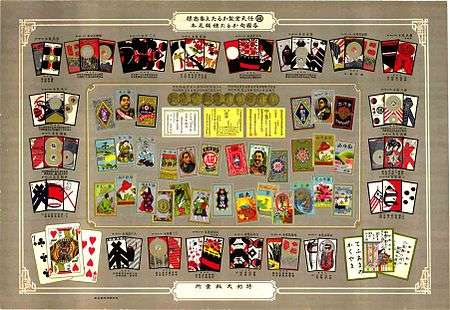
Karuta packs are classified into two groups, those that are descended from Portuguese cards and those from e-awase.[4] E-awase originally derived from kai-awase, which was played with shells but were converted to card format during the early 17th-century. The basic idea of any e-awase karuta game is to be able to quickly determine which card out of an array of cards is required and then to grab the card before it is grabbed by an opponent. It is often played by children at elementary school and junior high-school level during class, as an educational exercise. Chinese playing cards of the money-suited and domino types existed in Japan from at least the late 18th century until the early 20th century.[5][6] Their games would influence those played with the Hanafuda pack.
Portuguese-derived Karuta
Komatsufuda
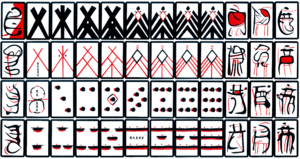
The first indigenous Japanese deck was the Tenshō karuta named after the Tenshō period (1573–92).[7] It was a 48 card deck with the 10s missing like Portuguese decks from that period. It kept the four Latin suits of cups, coins, clubs, and swords along with the three face cards of female knave, knight, and king. In 1633, the Tokugawa shogunate banned these cards, forcing Japanese manufacturers to radically redesign their cards. As a result of Japan's isolationist Sakoku policy, karuta would develop separately from the rest of the world. In order to hide the proscription of Portuguese derived cards, makers turned the cards into very abstract designs known as mekuri karuta. By the mid-20th century, all mekuri karuta fell into oblivion with the exception of Komatsufuda (Japanese: 小松札) which is used to play Kakkuri, a game similar to Poch, found in Yafune, Fukui prefecture.[8]
Unsun Karuta
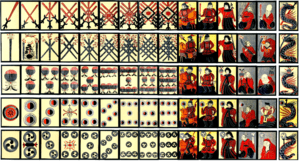
The Unsun karuta (Japanese: うんすんカルタ) deck developed in the late 17th century. It has five suits of 15 ranks each for a total of 75 cards. Six of the ranks were face cards. The Portuguese deck used to have dragons on their aces; the Unsun karuta made the aces and dragons separate cards. The order of the court cards change depending on whether it is the trump suit or not just like in Ombre. The new Guru suit used circular whirls (mitsudomoe) as pips. Unsun Karuta is still used in Hitoyoshi, Kumamoto to play hachinin-meri, a game descended from Guritipau, a relative of Ombre.[9] This game preserves some very archaic features such as inverted ranking for the pip cards in the three round suits. Inverted ranking is a feature found in Madiao, Khanhoo, Tổ tôm, Ganjifa, Tarot, Ombre, and Maw and is believed to have originated in the very earliest card games.
Kabufuda
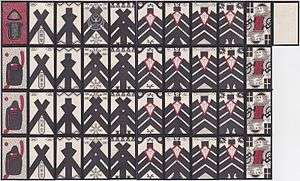
Kabufuda (Japanese: 株札) is another derivative of mekuri karuta but all the suits were made identical. It is used for gambling games such as Oicho-Kabu. They come in decks of 40 cards with designs representing the numbers 1 through 10. There are four cards for each number and the 10 (Jack) is the only face card.
Harifuda and Hikifuda
The gambling game of Tehonbiki can be played with either a Harifuda (張札) or Hikifuda (引札) set. Harifuda contains seven copies of cards numbered one to six in stylized Chinese numerals for a total of 42 cards. The 48-card Hikifuda or Mamefuda (豆札) has eight copies of cards with one to six coins, similar to the coins of a mekuri karuta set. In Tehonbiki, the player tries to guess which number from 1 to 6 the dealer has selected.[10][11] Some sets may include indicator cards to raise or hedge bets.
Hanafuda
Hanafuda (Japanese: 花札, lit. flower cards, also called Hanakaruta) are 48 card decks with flower designs originating from the early 19th century. Instead of being divided by 4 suits with 12 cards each, a hanafuda deck is divided by 12 suits (months) with 4 cards each. Hanafuda games are mostly fishing games. Their mechanics are derived from Chinese rather than European fishing games.[12]
E-awase Karuta
Uta-garuta
Uta-garuta (歌ガルタ, lit. "poetry karuta") is a card game in which 100 waka poems are written on two sets of 100 cards: one set is yomifuda (読札, lit. "reading cards"), which have the complete poem taken from the Ogura Hyakunin Isshu, and the other is torifuda (取り札, lit. "grabbing cards"), which each correspond to a yomifuda and have only the last few lines of the corresponding poem on them. One person is chosen to be the reader. As the reader reads a yomifuda, the players race to find its associated torifuda before anybody else does. It is often possible to identify a poem by its first one or two syllables. This game has traditionally been played on New Year's Day since 1904.[13] Competitive karuta has competitions on various levels with the Japan national championship tournament being held every January at Omi shrine (a Shinto shrine) in Ōtsu, Shiga since 1955.[14]
A few non-matching games exist that use only the yomifuda. Bouzu Mekuri (坊主めくり), is a simple game of chance originating from the Meiji period. Iro Kammuri (Color Crowns) is a 4-player partnership game that is related to Goita.[15][16] In both games, the poems are irrelevant, and the only parts of the cards that matter are the appearance of the poets such as their clothing, sex, or social status.
Ita-karuta
Ita-karuta (Japanese: 板かるた) is a variation found in Hokkaido. The torifuda are made of wood while the yomifuda remain the same or lack illustrations of the poets.[17][18] They are used to play a competitive partnership game called shimo-no ku karuta in which the last half of the poem is read.[19]
Iroha Karuta
Iroha Karuta (Japanese: いろはかるた) is an easier-to-understand matching game for children, similar to Uta-garuta but with 96 cards. Instead of poems, the cards represent the 47 syllables of the hiragana syllabary and adds kyō (京, "capital") for the 48th (since the syllable -n ん can never start any word or phrase). It uses the old iroha ordering for the syllables which includes two obsolete syllables, wi (ゐ) and we (ゑ). A typical torifuda features a drawing with a kana at one corner of the card. Its corresponding yomifuda features a proverb connected to the picture with the first syllable being the kana displayed on the torifuda. There are 3 standard Iroha Karuta variants: Kamigata, Edo and Owari. Each variant has its own set of proverbs based on the local dialect and culture. The Kamigata or Kyoto version is the oldest but the Edo version is the most widespread, being found all over Japan. The Owari variant existed only during the latter half of the 19th-century before being supplanted by the Edo version.
Obake karuta
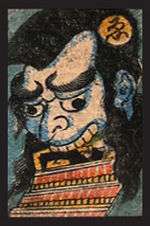
Obake karuta is an obsolete variation of Iroha Karuta unique to Tokyo. The cards were created in the Edo period and remained popular through the 1910s or 1920s.[20] Each card in the deck features a hiragana syllable and a creature from Japanese mythology; in fact, obake karuta means ghost cards or monster cards.[20] Success requires knowledge of Japanese mythology and folklore as players attempt to collect cards that match clues read by a referee. The player who accumulates the most cards by the end of the game wins.
Obake karuta is an early example of the common Japanese fascination with classifying monsters and creating new ones. The game is one of the earliest attempts by Japanese companies to categorize legendary creatures, label them, define them, and subsequently market them. As such, it is a precursor to the Godzilla films of the 1950s and later. Even more closely, obake karuta resembles the Yu-Gi-Oh! or Pokémon Trading Card Game, which also involves collecting cards that represent fabulous creatures. In fact, many Pokémon were designed specifically after creatures from Japanese mythology.[20]
References and notes
- Sakomura, Tomoko (2004). Asian Games: The Art of Contest. New York: Asia Society. pp. 267–269.
- Omuta City Miike karuta, history museum. Retrieved 22 February 2018.
- Miike Playing Cards and History Material Museum. Retrieved 22 February 2018.
- Mann, Sylvia (1990). All Cards on the Table. Leinfelden: Deutches Spielkarten-Museum. pp. 193–200.
- Morishima Chūryō. (1800). Keirin Manroku (桂林漫録). Edo (Tokyo).
- Hesse-Wartegg, Ernst v.. (1902). "Япония и японцы" (Japan and the Japanese). Page 237.
- Pollet, Andrea. Tensho Karuta at Andy's Playing Cards. Retrieved 30 July 2015.
- Kuromiya Kimihiko. (2005). "Kakkuri: The Last Yomi Game of Japan". The Playing-Card, Vol 33-4. p. 232-235.
- Depaulis, Thierry (2009). "Playing the Game: Iberian Triumphs Worldwide". The Playing-Card. Vol 38-2, p. 134-137.
- Pollett, Andrea. Tehonbiki at Andy's Playing Cards. Retrieved 30 July 2015.
- Pakarnian, John, "Game Boy: Glossary of Japanese Gambling Games", Metropolis, January 22, 2010, p. 15.
- McLeod, John; Dummett, Michael (1975). "Hachi-Hachi". The Playing-Card. 3 (4): 26–28.
- Bull, David. Karuta: Sports or Culture? at Woodblock.com. Retrieved 22 February 2018.
- Karuta Festival at Oumi Jingu. Retrieved 22 February 2018.
- McLeod, John. 100 poets at pagat.com. Retrieved 25 January 2016.
- Takahashi, Hironori. Iro Kammuri at Japanese Traditional Games. Retrieved 25 January 2016.
- Wintle, Simon. Uta Garuta at World of Playing Cards. Retrieved 25 January 2016.
- Pollett, Andrea. Japanese Matching Cards, part 1 at Andy's Playing Cards. Retrieved 25 January 2016.
- Takahashi, Hironori. Ita Karuta at Japanese Traditional Games. Retrieved 25 January 2016.
- Pflugfelder, Gregory M. "Display Case 8: Monster Merchandise (II)". Godzilla Conquers the Globe: Japanese Movie Monsters in International Film Art. Accessed 11 March 2006.
External links
| Wikimedia Commons has media related to Karuta. |
- Japanese playing cards of western origin: Portuguese-derived patterns.
- Andy's Playing Cards: Portuguese derived cards: An in-depth look at Portuguese-derived patterns.
- Andy's Playing Cards: E-awase playing cards (archived): E-awase type cards.
- Japanese Traditional Games: Card Games
- Edo Karuta Research Center (archived)
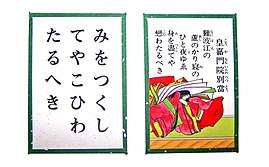
(Ita_karuta)(Page_073)_(20478559450).jpg)